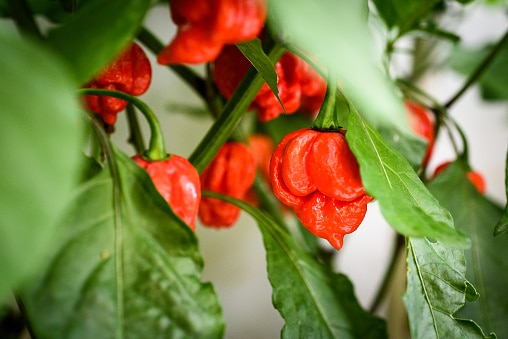The scorpion pepper has a pretty intimidating name… but is it really that hot?
Yes. It most certainly is.
The scorpion pepper’s formal name is the Trinidadian Scorpion Butch T pepper and it is incredibly hot. A scorpion pepper has been measured at 1,463,700 Scoville heat units. In 2011, when the test was done, it was the hottest pepper in the world.
How hot is a pepper that is 1,463,700 Scoville heat units? What even is the Scoville unit? Let’s find out!
What’s the Scoville scale?

Did you know birds are immune to the heat produced by peppers?
©Thomas Dutour/Shutterstock.com
The Scoville scale is the unit for measuring heat. Heat in scientific terms is identified as pungency. The more pungent a pepper is, the more hot it feels to folks consuming it. The higher the pungency, the higher the Scoville unit (SHU)!
What does a Scoville unit measure?
Heat or pungency in a pepper is related to the presence of capsaicinoids. Capsaicinoids contain the heat that’s found in the pepper. It’s what makes our mouths on fire! There are a few different types of capsaicinoids that can show up in a pepper, but the most common by far is capsaicin.
You may have heard that the capsaicin is in the seed, or even in the pithy part in the center of the pepper. The reality is that capsaicin is all over the pepper. However, it’s correct that the most prominent capsaicin is located in what’s called the placenta of the pepper. The placenta is the white portion in the middle of the pepper that the seeds attach to.
Capsaicin doesn’t just create a spicy flavor. It also burns skin and other areas of the body if it makes contact. If you’ve ever cut a jalapeno and then touched your eye, you know exactly what that burn feels like. It’s an oil-like compound that can spread easily, so be sure to wash your hands after interacting with a pepper.
Who invented the Scoville unit?
The Scoville unit was created by Wilbur Scoville back in 1912. The unit emerged as he was designing an experiment to test the heat of various peppers. However, when he first created the test (which was called the Scoville organoleptic test), it was merely a taste test. It wasn’t terribly rigorous and was, in fact, a bit subjective. Peppers were ranked based on heat and thus the Scoville scale was born.
Since then, more precision and scientific processes have evolved to determine the Scoville unit of a pepper. A method called high-performance liquid chromatography is used to measure the capsaicinoid concentration present in the peppers. This has been the best way to determine the SHU of a pepper since the 1980s. It’s much more objective, so the taste test is reserved for family gatherings and internet challenges!
How hot is the scorpion pepper?

Hotter peppers are wrinkly due to genetics. The wrinkles don’t make them hotter, but most hot peppers are wrinkly!
©_jure/iStock via Getty Images
These peppers are really, really hot.
In order to understand the value of a 1,400,000 reading on the Scoville scale, it’s important to understand the range. The SHU range is pretty gigantic. It goes from 0 all the way up to 16 million. A bell pepper has zero SHUs, while pure capsaicin has 15 or 16 million SHUs.
So considering the fact that pure heat is 16 million SHUs… the scorpion pepper is pretty darn hot!
Let’s consider some other peppers you may have come across.
It’s not uncommon for the casual eater to encounter a jalapeno. Jalapenos are 2,500-8,000 SHUs. Note that each pepper’s SHUs range due to various capsaicin concentrations inside each individual pepper. Scorpion peppers, at their lowest measure, are still around 1,200,000 SHUs. Ouch!
If you’re even more into heat, you may have eaten a Thai pepper or even a Habanero. Thai peppers are 50,000-100,000 SHUs and Habaneros are 100,000-150,000 SHUs. So while those peppers are hot, they are only a fraction of the heat of a scorpion pepper!
Is the scorpion pepper the hottest pepper?
Not anymore.
At the time the scorpion pepper was researched in 2011, it was thought to be the spiciest pepper on Earth. Since then, the California Reaper pepper has taken first place for pungency. The California Reaper has hit 1,569,300 Scoville units! While the two peppers are pretty close, California Reapers win!
Is it safe to eat a scorpion pepper?

Eating spicy food can be a skill that you learn! Start eating spicier and spicier food and it’ll get easier.
©nicoletaionescu/iStock via Getty Images
It can be a bit risky to eat a food that hot. In general, it will likely make you feel very unpleasant. Upon initial consumption, you may feel a burning sensation spread throughout the body. Additionally, your nose will get runny and you’ll start to sweat. Your stomach probably won’t be feeling too good, either.
Scientists are still researching whether or not there are large consequences for consuming super spicy foods like a scorpion pepper. For now, approach with caution!
Thank you for reading! Have some feedback for us? Contact the AZ Animals editorial team.








